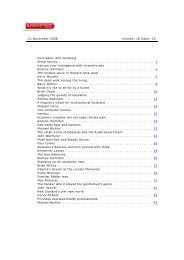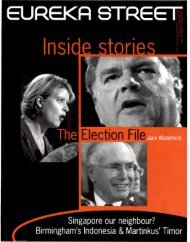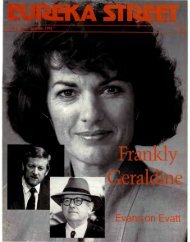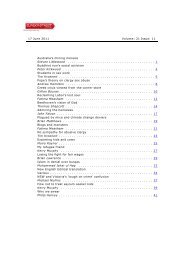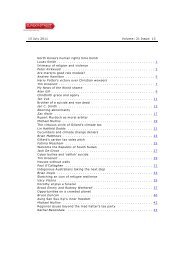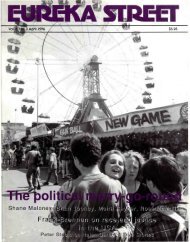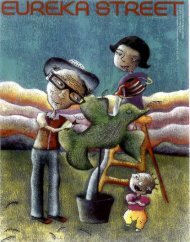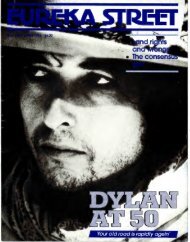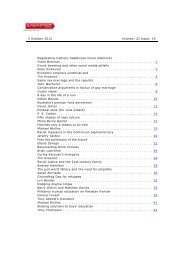25 January 2008 - 1 February 2008 Volume: 18 Issue: 2 Cricket ...
25 January 2008 - 1 February 2008 Volume: 18 Issue: 2 Cricket ...
25 January 2008 - 1 February 2008 Volume: 18 Issue: 2 Cricket ...
Create successful ePaper yourself
Turn your PDF publications into a flip-book with our unique Google optimized e-Paper software.
Truth about Aboriginal missions requires study<br />
BOOK REVIEW<br />
Robin Koning<br />
<strong>Volume</strong> <strong>18</strong> <strong>Issue</strong>: 2<br />
<strong>25</strong> <strong>January</strong> <strong>2008</strong> - 1 <strong>February</strong> <strong>2008</strong><br />
Loos, Noel. White Christ, Black Cross: The Emergence of a Black Church.<br />
Canberra: Aboriginal Studies Press, 2007, website .<br />
What was going on in Christian missions to indigenous<br />
Australians? This is one of the underlying questions raised by Noel<br />
Loos’ book White Christ, Black Cross: The Emergence of a Black Church.<br />
He addresses this question through an exploration of the Anglican<br />
Church’s indigenous outreach, with a particular focus on Yarrabah<br />
in northern Queensland and the work of the Anglican Board of<br />
Missions (ABM).<br />
This kind of detailed study of mission history is essential if we<br />
are to move beyond clichés about mission history and its effect on indigenous<br />
Australia. Too often, generic statements about missionaries colluding with<br />
colonialism and destroying indigenous cultures are presumed to say all that needs to<br />
be said about this aspect of contact history. On the other hand, some Christians can<br />
whitewash mission history, as though any injustice suffered was justified by the fact<br />
that people gained access to the saving Gospel of Christ.<br />
Both these positions call for a more discerning account of concrete mission histories<br />
for two reasons: to do justice to indigenous agency in the encounter with Christianity,<br />
so that indigenous people are not presented as mere victims; and to do justice to the<br />
ways in which the missionary agenda was not only parallel with that of other colonial<br />
forces, but also diverged from it.<br />
In Loos’ book, we find the sort of case study that helps to offer this nuance. He<br />
shows how missionary attitudes, while very much culturally conditioned, were also,<br />
in some cases at least, counter-cultural. While not denying the view of many<br />
missionaries that indigenous peoples were only capable of being ‘civilised’ to the<br />
level of the British working classes, he notes also the firm conviction as to their<br />
fundamental humanity.<br />
He points to the ABM’s early awareness of the devastation caused by<br />
dispossession and of the responsibilities incumbent on those who benefited from this<br />
dispossession. A major character in Loos’ story is Ernest Gribble, a veteran of a<br />
©<strong>2008</strong> EurekaStreet.com.au 27



